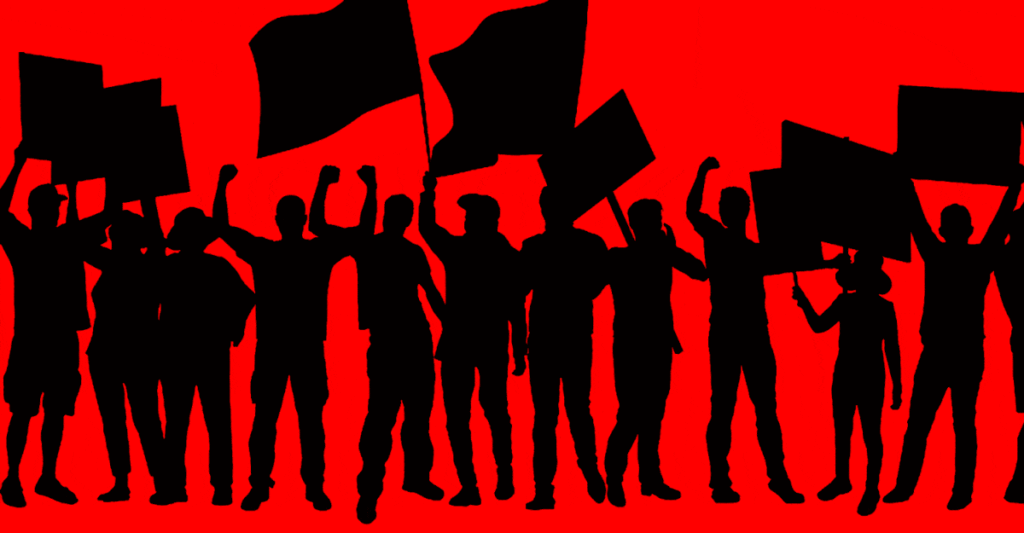Last Saturday, I paid a visit to a little slice of the resistance in its current, attenuated form. Since Donald Trump’s second inauguration, there have been many street protests, but they have been small and diffuse: a few hundred people angered by the defunding of USAID, or a couple thousand in support of national parks. The most organized effort so far, the 50501 movement (for “50 states. 50 protests. 1 movement.”), is a coalition of activists whose name telegraphs breadth much more than depth.
At an intersection outside a Tesla showroom in the Gowanus neighborhood of Brooklyn, about 200 people were gathered on the sidewalk. They banged tambourines and clanged cymbals, trying to get passing trucks and cars to honk against Elon Musk, Trump’s most important adviser and a purveyor of electric cars. Of all the responses to the new administration, the anti-Tesla protests have left a bruise—as of this writing, the company’s stock has declined by about half since December. There were signs demanding Musk’s deportation, and one that asked drivers to Honk If You Think Elon Is a Dork. Someone in a gorilla suit held up a placard that read He Kills Monkeys, Too.
For all the energy on the street—and it was energetic—there was a preponderance of gray hair, and not many young people or strollers in evidence. Those who showed up seemed to have a highly developed muscle memory for activism, going back perhaps to the anti–Iraq War demonstrations in 2003, or even Vietnam. This appeared to be a protest by and for a committed core. Maybe the most revealing poster was one that declared The Protests Will Get Bigger Until the Constitution is Respected. This was a threat, of course, but also an acknowledgment that there was plenty of room to grow.
Nevertheless, for those in the exhausted anti-Trump coalition, these bursts of opposition are giving hope. Today, a coalition of liberal groups under the banner “Hands Off!” is planning hundreds of such actions around the country. This is the kind of activity that has led members of Harvard’s Crowd Counting Consortium, which tracks acts of civil dissent, to conclude recently that the resistance is “alive and well,” with protests “far more numerous and frequent than skeptics might suggest.” They have what at first glance seems like an unexpected finding: In February 2025, twice as many protests took place as in February 2017, during the tumultuous beginning of Trump’s first term: 2,085 versus 937. The major caveat is that what they count as a protest event could be a couple of people handing out flyers on campus. Altogether, the number of actual protesters is far, far below what it was eight years ago.
The best estimate for this past February was somewhere from 125,000 to 184,000 participants, according to Jeremy Pressman, one of the consortium’s co-directors and a professor at the University of Connecticut. This would put the average protest size anywhere from 60 to 88 people. In March, Pressman said, those numbers increased significantly, but the per-protest average stayed roughly the same.
What this suggests, at best, is a different model of protest movement: highly decentralized, moving at a snail’s pace, more a slog than a resistance. “Something is happening,” the journalist Ali Velshi wrote on MSNBC last week, “a different kind of movement building right now, one that has had steady and sustained momentum.” In The Bulwark, Jonathan V. Last emphasized the strategic advantage of a movement that makes its way from the hinterlands toward Washington.
It is different, but is it better? Is a single protest of 100,000 people equal to 1,000 actions with 100 people at each? I posed this zen koan of a question to Erica Chenoweth, a Harvard professor and Consortium co-director who coined the idea that if any protest movement drew 3.5 percent of a country’s population, it could achieve its goals. (That would equal nearly 12 million people in the United States today.) Does it matter how you get to this figure, all at once or bit by bit? “We don’t really know,” Chenoweth told me, “and conceivably either path produces momentum.”
So far into Trump 2.0, though, the path of decentralized slowness has had a paradoxical effect: It’s giving activists lots to do but is leaving a much larger population of dissenters without an expressive outlet. What makes a disaffected Gen Zer or a busy Millennial parent drop what they are doing and head into the streets is very different from what motivates hard-core protesters to pick up their cymbals. That much larger group needs to feel both the safety and the collective impact that comes with a mass march. “Power springs up between men when they act together and vanishes the moment they disperse,” the philosopher Hannah Arendt wrote in The Human Condition. Most people join protests to express that power, not to emphasize their marginality. And it is precisely this type of action that, in the face of one barrier after another, feels more difficult than it ever did.
Trump’s first term was punctuated by a series of monster gatherings: the Women’s March that greeted his inauguration (estimated at as many as 4.6 million people all over the country), the March for Our Lives following the 2018 Parkland shooting (1.2 million), and—dwarfing all previous American protest movements—the Black Lives Matter demonstrations after the killing of George Floyd (anywhere from 15 million to 26 million people, according to polls taken at the time). The Women’s March was highly organized and concentrated, while the protests in June 2020 were largely spontaneous and spread out. But what made all of these significant was the measure by which protest has long been judged: the overwhelming numbers of people who took part.
On its face, the slackening of interest in demonstrating against Trump in his second term—despite the preponderance of issues that trigger his opposition every day—can be understood simply as a change in the political atmosphere. Trump’s 2017 win was a shock for liberals expecting to inaugurate the first female president. His failure to win the popular vote made his election feel contestable, even illegitimate. And powerful people, even a number of Republicans, were ready to stand up to Trump’s overreach. All of this created a sense that there was a door that protest could push open. None of these factors operates in 2025: Trump is not a surprise, he won the popular vote, and both his party and the business elite are fully on his side. Pressman wondered if this has created “a different kind of shock,” one that is more destabilizing than motivating: “Maybe people were just kind of pushed on their back feet. And it takes a while, or ever, to be involved in it.”
After the University of Glasgow lecturer Michael T. Heaney surveyed participants from both the Women’s March and January’s much shrunken People’s March, he emerged with a clear contrast. There was a 12 percent drop in enthusiasm about politics, he told me; “hope” as a motivator for protesting fell by 10 percent, and “pride” by 9 percent. What rose from 2017 to 2025? “Frustration,” by 3 percent, and “anger,” by 8 percent.
Alongside demoralization runs justifiable caution; the act of protest itself has become more dangerous. Not only has the president said that he would have little compunction about using the military to deal with “the enemy from within,” but the tactics of surveillance—including facial recognition, geolocation tracking, and AI-enhanced identification—have gotten more pervasive and sophisticated. The police and the FBI have long used and abused tools for monitoring protest—this sordid history goes back to COINTELPRO in the 1960s. But the average protester at a peaceful 20th-century gathering could at least assume that they would melt into a sea of indistinguishable people. Technology has made that impossible. There is no safety in numbers. You cannot disappear.
Simply being present at a protest makes you vulnerable, as Chris Gilliard, a Just Tech fellow at the Social Science Research Council, told me: “All the devices that people carry and wear are constantly extruding data, from the car they might have used to get there to the cameras in subway stations to their watches and their phones and everything else you can imagine.” Among the safety instructions provided by an organizer of today’s nonviolent demonstrations was the bolded sentence “Do not assume you are safe.” Also: “MASK. UP … disable location, biometrics and data on your phone, at the very least. Have your emergency contacts written on your body.” This is not a welcoming message for an infrequent protester or a citizen looking to voice her concern for the first time. No wonder that a smaller, local protest is more of a draw at the moment. “It’s easier to control; it’s just easier to call it off suddenly if you need to; it’s easier to get away,” Chenoweth told me. “There’s lots of reasons why smaller, more nimble groups would feel more safe.”
There are also an increasing number of laws targeting protest. The volume of federal and state legislation has spiked in the past few years, and particularly since January; 41 anti-protest bills have been introduced in 21 states and in Congress in 2025. This crop includes bills by Congress against protesters “deliberately delaying traffic,” disrupting in any way the construction of a pipeline, or wearing a mask that “oppresses” another person. Among the Trump administration’s demands on Columbia University in return for restoring $400 million in funding was a ban on masks, which many peaceful protesters wear not to menace others but to avoid being identified by facial recognition.
Most of the movements we now consider heroic were originally perceived as lawless nuisances, but Trump has reframed and stigmatized protest in novel ways, conflating nonviolent gatherings with destructive mobs. The reactions to the killing of George Floyd, which did include acts of vandalism and looting, were overwhelmingly peaceful, according to a study by the group Armed Conflict Location & Event Data. But the Black Lives Matter protests of that summer are now remembered by Trump and his supporters as nothing more than a series of riots. The pro-Palestinian activism of the past year and a half has been characterized at times by intimidation, which may have undermined the reputation of protest. But Trump has gone further by painting all legitimate expressions of distress over mass death in Gaza as “pro-Hamas” and moving to deport noncitizens who had anything to do with it. Mahmoud Khalil, the former Columbia graduate student whose deportation is now pending, became an obvious target for the government precisely because he openly protested, unmasked.
As recently as two years ago, the act of picking up a sign and walking out your door to join a march could feel affirming, even joyous. Now it comes with the fear of surveillance and recrimination, the possibility of felony arrest, and, as a result, a deep sense of resignation.
Why does size matter when it comes to protest? Chenoweth’s magic number notwithstanding, the reasons are less tangible than a simple equation. Large demonstrations are a performance of plurality, with individuals transcending their own individuality to express a larger will. This can happen only when the public around you is more than just the person in the gorilla suit who usually shows up to these things. The experience can be bolstering. It can reassure you not just that you aren’t alone, but that you are a citizen among citizens. The sociologist Émile Durkheim had a wonderful phrase for this: collective effervescence.
And for those watching from on high—senators, judges, CEOs—mass protests are physical manifestations of public opinion. They might make a singular person in the throng invisible, but they make their opinion super-visible. Whatever one feels in retrospect about the 2020 BLM protests, every sector of society had to contend with their enormity—it was a moment when even the CEO of JP Morgan Chase, Jamie Dimon, seemed to feel compelled to take a knee. Trump’s crusade to root out DEI is, in many ways, a backlash to the changes these protests spawned. Outside the U.S., consider a recent textbook example of mass mobilization leading to a successful outcome: the 2023 marches in Israel in response to Benjamin Netanyahu’s judicial reforms. These protests effectively shut down the country and forced Netanyahu to relent.
The most optimistic story activists tell about what is happening now is one of incubation: You can’t get to big unless you go through small. Groups are forming coalitions, developing organizational structures, testing the waters locally. This is crucial work for any movement that wants to be long-lasting. One of the major critiques of the protests that blazed so brightly in Trump’s first term is that they largely flamed out very quickly. So this time could be different. Hunter Dunn, a student at Pepperdine University who is also a national press liaison for the 50501 movement, told me that he is a rarity at these protests because he isn’t a Gen Xer or a Boomer. But as a young person fighting what he described as the hopelessness of his fellow young people, he too has visions of the movement culminating in a classic 1963-style march on Washington. “I don’t think we can just get millions of people there tomorrow if we announce that,” he said. “We have to build towards it over weeks, months, even maybe over a year, because it takes that long to build a movement that is strong enough to go to Washington, go there peacefully, but go there unafraid of the government.”
Yet there is also a pessimistic version, one the activists are not telling: that this is a slog without end. Not a slow gathering with a grand finale, but a defanged alternative to mass mobilization; not the prelude to an eruption, but a reliably timed release valve.
There is no reason yet to think that this will be the story of protest in Trump’s second term. Last week, Senator Chris Murphy said that Democratic Party resistance might require “mass-scale mobilization.” This weekend’s protests may well be an early inflection point in that direction—or they may just continue the scattered pattern seen so far. A few activists also pointed me to the large rallies that have greeted Bernie Sanders and Alexandria Ocasio-Cortez on their ongoing “Fighting Oligarchy” tour. What was remarked upon was the size of the crowds—more than 30,000 in Denver—the kind of “surprising number,” as Chenoweth put it, that matters for creating momentum.
On a Reddit post drumming up support for the country-wide April 5 protests—more than 1,000 are planned—one user had their own unequivocal answer to the question of how best to build momentum. “We ask you to make it to the largest planned protest you are able to,” protectresist wrote. “200 people each at 100 protests will not make the news. 20,000 people at one protest will.”
Premium IPTV Experience with line4k
Experience the ultimate entertainment with our premium IPTV service. Watch your favorite channels, movies, and sports events in stunning 4K quality. Enjoy seamless streaming with zero buffering and access to over 10,000+ channels worldwide.

















